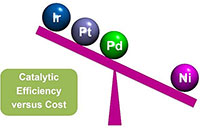
Fundamental Catalysis Enabling a Zero-Carbon-Footprint Future
By Johannes Lercher
 Economic wealth is directly correlated with the energy used to perform work, enable mobility, and provide the goods required to ensure the well being of individuals. Today, more than 80 percent of chemicals and energy carriers are synthesized from fossil (hydro)carbon resources, which has led to an unprecedented increase in the levels of carbon dioxide (CO2) in the atmosphere. Nearly all these chemicals and energy carriers are made using catalysis in at least one of the processing steps. Catalysis is, therefore, not only key to sustainable development, characterized by transition from the current fossil carbon-based energy carriers to a zero-carbon footprint energy future, but it will also secure energy independence. Read more.
Economic wealth is directly correlated with the energy used to perform work, enable mobility, and provide the goods required to ensure the well being of individuals. Today, more than 80 percent of chemicals and energy carriers are synthesized from fossil (hydro)carbon resources, which has led to an unprecedented increase in the levels of carbon dioxide (CO2) in the atmosphere. Nearly all these chemicals and energy carriers are made using catalysis in at least one of the processing steps. Catalysis is, therefore, not only key to sustainable development, characterized by transition from the current fossil carbon-based energy carriers to a zero-carbon footprint energy future, but it will also secure energy independence. Read more.
Scale-up of Aviation Biofuels from Alcohols Reaching New Heights

Collaborating closely with industrial partner LanzaTech, Pacific Northwest National Laboratory researchers recently reached a major milestone in the production of alternative jet fuels. Using industrial byproducts and a PNNL-developed catalyst in a two-stage process, the research team produced 5 gallons of synthetic paraffinic kerosene. While this may sound like a small amount of fuel, it's the required quantity available for the next stage of testing and scaling-up of production.
Over the course of a 10-hour flight, a passenger airliner burns roughly 36,000 gallons of fuel—about one gallon every second. With nearly 30,000 commercial flights taking off each day in the United States, developing cleaner alternative sources of jet fuel is a priority for the airline industry and DOE's Bioenergy Technologies Office (BETO).
With funding from BETO, Pacific Northwest National Laboratory (PNNL) has been working with industry-partner, LanzaTech, to convert alcohols derived from captured carbon monoxide, a byproduct in the production of steel, into synthetic paraffinic kerosene, a non-fossil-based jet fuel. The technology not only provides a viable source of sustainable jet fuel but also reduces the amount of greenhouse gasses emitted into the atmosphere. Read more.
Five Cents About Nickel Catalysts
 Affordability is one of the greatest challenges to the spread of catalyst-based energy technologies. The main reason is the reliance on precious metals, such as platinum, whose market value is ~$950 an ounce. In industry, platinum-containing catalysts dramatically enhance the speed of different reactions to make a variety of fuel sources viable for harvesting energy.
Affordability is one of the greatest challenges to the spread of catalyst-based energy technologies. The main reason is the reliance on precious metals, such as platinum, whose market value is ~$950 an ounce. In industry, platinum-containing catalysts dramatically enhance the speed of different reactions to make a variety of fuel sources viable for harvesting energy.
Scientists at two Energy Frontier Research Centers (EFRCs), the Center for Molecular Electrocatalysis and the Inorganometallic Catalyst Design Center, have made advancements in developing nickel-based catalysts. Nickel, whose market price of less than $4 a pound, is an attractive alternative to expensive and rare metals. Using computational methods and experimental techniques, staff at these EFRCs have revealed important design principles for future nickel catalysts. Read more.
August 2016
Catalysis News & Research:
Lercher Receives International Award for Catalysis Research. Congratulations to Johannes Lercher, Director of PNNL's Institute for Integrated Catalysis, for winning a prestigious 2016 Eni Award, an international benchmark for research in the field of energy and the environment. Lercher received the New Frontiers in Hydrocarbons-Downstream prize for his research on novel catalytic strategies to alkenes and alkanols. Read more.
A Watery Roadblock in the Pathway to Biofuels. Scientists from PNNL and a major German university showed how water molecules affect catalysis when producing fuels from agricultural waste and other biomass. Read more.
How to Heal Broken Bonds, Catalyst Style. A PNNL team show how to fix interior defects in zeolite catalysis to create biofuels from paper manufacturing waste, possibly leading to a more stable and efficient catalyst for biofuel production. Read more.
Catalyze It! Special Issue Highlights Drive for Discoveries at National Labs. A special issue of ACS Catalysis features groundbreaking catalysis research from PNNL and ten other national laboratories. Read more.
Chromium Breaks the Toughest of Bonds, with the Right Support. For more than 30 years, chromium failed to turn nitrogen gas into ammonia. But scientists at the Center for Molecular Electrocatalysis created a 12-atom ring structure that partially surrounds the metal and offers a stable environment for the metal to drive the reaction Read more.
If you have feedback – ideas, suggestions or questions – about IIC's Transformations, please contact Julie Wiley